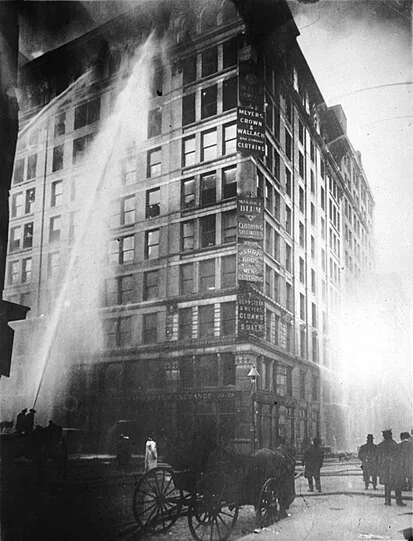In one of the worst fires in the United States, 123 young women died

25th March is known in many countries as Mother’s Day – a holiday dedicated to mothers and their love. However, this date also bears meaning in the history of labor rights. On that day in 1911, a fire broke out at the Triangle Shirtwaist factory at Greenwich Village, Manhattan.
It is one of the worst industrial accidents in New York history and in general for one of the worst in US history. 146 textile workers died in the fire, including as many as 123 women and girls. Most of the victims were young Italian and Jewish immigrants, mostly in teenage and in the early twenties.
The fire broke out around 4.40 pm below the table of one of the tailors on the eighth floor of a factory, which did not extinguish the cigarette ogorka well. The fire quickly captured the waste goods that were accumulated in a wooden box under the table. Combined with hanging fabrics and flammable materials in the room, the fire spread quickly.
The first fire alarm was launched only in five minutes, when the passerby informed the firefighters. One of the main problems in the evacuation was that the door of the staircases and outputs was locked, as employers wanted to prevent places and uncontrolled breaks. As a result, many workers were trapped in a burning building. Many girls jumped through the windows in despair and died at the fall.
According to the tragedy, the New York State Assembly established a committee to investigate working conditions in factories. Photo: Unknown Author/Wikipedia
Book Triangle: The Fire That Changed America He states that the bookkeeper on the eighth floor managed to inform the employees of the tenth floor over the telephone, but the ninth floor did not occur. There, workers found that they were burning only when they saw the fire. The staircase to the street quickly became impassable due to the smoke, and the door to the second staircase was locked, with a key with a key escaping.
The outdoor fire staircase was poorly built and collapsed under the weight of people and due to heat, killing 20 people in the fall. The rest died of suffocation or jumped through the windows in despair. The father later described the horrific scenes of people jumping to death.
Some managed to escape the roof, including the factory owner. In April 1911, they were accused of negligence, but were acquitted in December of the same year, as the prosecution failed to prove that they knew about the locked door. In a civil lawsuit in 1913, they were found responsible for the death of workers and had to pay compensation for $ 75 per victim, while they received a much higher sum from the insurance company.
The next morning, in New York’s textile district, more than 15,000 shirt blouse makers interrupted. They demanded a 20 % salary raise, a 52-hour work week and an additional payment for overtime. The local union, together with the Workers’ Trade Unions, organized meetings in English and Jidiš in many halls, where they discussed the plans for the strike. When the strike began the next day, more than 20,000 workers from 500 factories have left jobs. More than 70 smaller factories agreed to trade union requirements in the first 48 hours.
According to the tragedy, the New York National Assembly established a committee to investigate factory conditions. The Commission conducted numerous investigations and interviewed witnesses and prepared 3500 pages of documentation. Their findings have led to the adoption of new laws on labor law in New York. Socialist and unionist Rose Schneiderman in a high -profile speech, warned that workers can only rely on themselves. The Security Committee was created, which, in cooperation with the political organization Tammany Hall, provided support for legislative changes, such as the 54-hour work week. In the years 1911-1913, 60 of the 64 proposed laws were adopted, which included better accessibility of buildings, fire requirements, installation of alarms and automatic sprays, and improved sanitary conditions for workers. They also introduced restrictions on working hours for women and children.
The Department of Fires at New York firefighters (FDNY BUREU OF FIRE Prevention), which began with inspections in 1912, was also established as a direct consequence of the fire. Today, this unit is composed of more than 600 people and its headquarters in Brooklyn.
To commemorate the victims of the fire, 11. October 2023, at the corner at the corner of Washington Place and Greene Street erected a lasting monument – a steel structure with cut names of the dead, through which sunlight projects their names on the wall of the building.






/s3/static.nrc.nl/images/gn4/data133306995-b21914.jpg)
